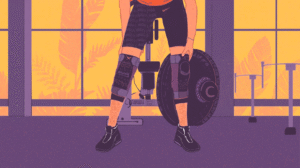Long hours behind the wheel, whether commuting to work, driving for business or taking road trips can cause significant discomfort in the lower back, hips and tailbone. Traditional car seats are often designed for short-term use and lack sufficient lumbar support or ergonomic features. With time sitting on an unsupported surface can lead to chronic musculoskeletal pain, poor posture and even spinal issues.
Memory foam car seat cushions have emerged as a practical and effective solution to these problems. Made from high-density viscoelastic foam, these cushions conform to the body’s natural curves, distribute weight evenly and relieve pressure on critical areas like the lumbar region and coccyx. They are designed to provide both comfort and postural support, making long drives less taxing on the body.
Beyond pain relief, memory foam cushions encourage proper posture, which can prevent long-term musculoskeletal problems. By supporting the spine’s natural alignment, reducing slouching, and minimizing pressure points, these cushions allow drivers to maintain comfort and focus over extended periods [1]. Additionally, many designs are portable and versatile, suitable for office chairs, wheelchairs or home seating, making them a practical investment for overall musculoskeletal health.
This article explores the causes of driving-related discomfort, how memory foam car seat cushions work, their benefits, usage tips, and guidance for selecting the most suitable cushion for your needs.
Understanding Driving-Related Discomfort
1. Common Causes of Pain
Prolonged sitting in traditional car seats can place stress on multiple parts of the body. The lumbar spine often lacks adequate support, leading to compression of vertebrae and intervertebral discs. Tailbone pain is commonly experienced due to direct pressure on the coccyx during long drives, while hip discomfort arises from limited movement and muscle tension. Poor posture, such as slouching or leaning forward, further exacerbates these issues, creating a cycle of pain and fatigue.
Drivers who spend hours commuting may also develop numbness in the legs due to restricted circulation and pressure points. Additionally, seat materials that are too firm or too soft can contribute to uneven weight distribution, worsening discomfort over time.
2. Health Impacts of Poor Seating
Chronic sitting without adequate support can lead to musculoskeletal imbalances. Common health effects include lower back pain, stiffness in the hips, tailbone soreness, and weakened postural muscles. Over time, spinal misalignment may occur, increasing the risk of herniated discs or nerve compression. Pressure points from hard surfaces can also affect circulation, leading to fatigue, tingling, or numbness in the legs.
Long-term poor posture and discomfort can affect daily activities, reducing concentration and overall quality of life. Studies indicate that proper lumbar support and ergonomic interventions significantly reduce pain and improve posture (Fritz et al., 2011).
3. Effects on Daily Life
Driving-related discomfort does not only affect the body, it can impact productivity, focus, and overall well-being. Pain and fatigue can reduce alertness, impair reaction times, and make driving less safe. Outside of the car, persistent musculoskeletal strain may limit physical activity, sleep quality, and general comfort, emphasizing the importance of supportive seating solutions.
What is a Memory Foam Car Seat Cushion?
Definition and Function
A memory foam car seat cushion is designed to mold to the contours of your body, distributing weight evenly to reduce stress on the spine, hips, and tailbone. The viscoelastic material responds to both heat and pressure, providing customized support that adapts to each individual’s body shape. This reduces strain on postural muscles and maintains spinal alignment over long periods of sitting.
Types of Memory Foam Cushions
- Full-Seat Pads: Provide overall comfort and support for the entire seating area.
- Lumbar Support Pillows: Focus on the lower back to maintain natural curvature and relieve lumbar pain.
- Coccyx-Cutout Cushions: Feature a tailbone cutout to alleviate direct pressure on the coccyx.
- Contoured or Adjustable Designs: Adapt to individual body types and preferred seating positions.
How They Work
Memory foam cushions work by distributing pressure evenly across the sitting surface. They reduce concentrated stress points, which helps prevent pain in the lumbar spine, hips, and tailbone. By promoting proper alignment and reducing slouching, these cushions improve posture and can alleviate discomfort from long drives or daily commuting.
Key Benefits of Memory Foam Car Seat Cushions
1. Pain Relief and Support
Memory foam cushions provide targeted support to reduce lower back, hip, and tailbone pain. By maintaining proper alignment and supporting weakened postural muscles, they can help relieve chronic discomfort caused by long-term sitting.
2. Improved Posture Awareness
Using a memory foam cushion encourages drivers to sit upright, reducing slouching and forward-leaning habits. This reinforcement helps build better posture habits over time, which can benefit musculoskeletal health even outside of the car.
3. Enhanced Comfort on Long Drives
The cushion’s soft yet firm support minimizes fatigue by adapting to the body’s shape. Contoured designs cradle the spine, distributing weight evenly and reducing pressure on critical areas, making long drives more comfortable.
4. Durability and Maintenance
High-density memory foam retains its shape over time, offering long-lasting support. Many cushions come with removable, washable covers, making maintenance easy and promoting hygiene.
5. Versatile Use
Memory foam cushions are portable and lightweight, suitable not only for cars but also for office chairs, wheelchairs, or home seating [2]. Their versatility allows users to enjoy comfort and support in multiple settings.
How to Use a Memory Foam Car Seat Cushion Effectively

Using a memory foam car seat cushion correctly can significantly enhance comfort, relieve pain, and promote proper posture during long drives. Simply placing the cushion on the seat is not enough; proper positioning, posture, and care are essential to maximize its benefits.
1. Correct Placement
Ensure the cushion is positioned so your hips, tailbone, and lower back are fully supported. Lumbar pillows should align with the natural curve of your lower spine, while coccyx-cutout cushions relieve pressure on the tailbone. Proper placement ensures even weight distribution and prevents unnecessary strain on the spine, hips, and buttocks.
2. Maintain Good Posture
Adjust your car seat to support an ergonomic posture. Keep knees bent at a 90-degree angle, feet flat on the floor, and shoulders relaxed. The backrest should support the spine’s natural curvature, helping prevent slouching or forward-leaning tendencies that may aggravate discomfort.
3. Take Regular Breaks
Even with a cushion, prolonged sitting can cause stiffness and fatigue. Schedule short breaks every 1–2 hours to stretch, walk, or perform light mobility exercises. This improves circulation, prevents pressure buildup, and reduces muscle tension in the lower back, hips, and tailbone.
4. Combine Supports if Needed
For individuals with chronic pain or multiple pressure points, pairing a full-seat cushion with a lumbar pillow can provide comprehensive relief. This combination supports different areas of the spine and helps maintain correct posture for long durations.
5. Care and Maintenance
High-density memory foam cushions are durable but require proper care. Rotate the cushion regularly to prevent uneven compression and maintain its shape. Wash removable covers to keep the cushion clean and breathable, and avoid exposing the foam to excessive heat or moisture. Proper care extends the cushion’s lifespan and preserves comfort.
Choosing the Right Memory Foam Car Seat Cushion
Selecting the right memory foam cushion is crucial to ensure maximum comfort, pain relief, and posture support [3]. With numerous options available, understanding key features can help make an informed choice.
1. Identify Your Primary Need
Pinpoint the main area of discomfort: lumbar spine, tailbone, or overall seating. Lumbar cushions provide targeted lower back support, coccyx-cutout designs relieve tailbone pressure, and full-seat pads offer overall comfort during long drives. Choosing the right type ensures the cushion addresses your specific needs.
2. Evaluate Cushion Features
Consider thickness, firmness, and ergonomic design. Cushions that are too soft may fail to provide support, while overly firm cushions can cause discomfort. Contoured or wedge-shaped designs enhance spinal alignment and encourage proper posture. Adjustable cushions allow you to customize support for your body type and seating position.
3. Check Compatibility
Ensure the cushion fits your car seat properly. Verify the dimensions, shape, and seat coverage. Some high-backed or bucket seats may require specific designs for stability. Anti-slip bases or secure straps help maintain the cushion’s position while driving.
4. Material and Maintenance
Opt for breathable memory foam with removable, washable covers. Breathable fabrics prevent heat buildup during long drives while washable covers maintain hygiene. High-quality memory foam retains its shape over time, offering consistent support and durability.
5. Brand and Reviews
Reputable brands with positive customer feedback often provide higher quality and better ergonomic support. Reading reviews can offer insights into comfort, durability, and real-world performance. Products recommended by physical therapists or ergonomics experts are typically more reliable.
Complementary Lifestyle and Driving Habits
- Ergonomic Adjustments: Ensure proper seat height, lumbar support, and steering angle.
- Sitting Posture: Maintain knees at 90°, feet flat, shoulders relaxed.
- Regular Breaks: Stretch or walk during long drives to relieve tension.
- Strengthening Exercises: Strengthen back, core, and hip muscles to support posture.
- Stress Management: Use relaxation techniques to prevent neck and shoulder tension.
Conclusion
Memory foam car seat cushions provide an effective, non-invasive solution for drivers seeking comfort and pain relief. By improving posture, distributing weight evenly, and reducing pressure on the spine, hips, and tailbone, these cushions make long drives safer and more comfortable. Selecting the right cushion, using it correctly and maintaining proper driving habits ensures maximum benefit.
Looking for more health and wellness solutions? Don’t miss these related guides:-
Frequently Asked Questions:
1. What is a memory foam car seat cushion, and how does it work?
A memory foam cushion conforms to your body shape, distributing weight evenly. It reduces pressure on the spine, hips, and tailbone while supporting proper posture.
2. Can it relieve lower back, hip, or tailbone pain during long drives?
Yes, it alleviates pain by providing targeted support to the lumbar spine, hips, and tailbone. Regular use helps reduce discomfort and fatigue.
3. How thick should a memory foam seat cushion be for maximum comfort?
Most effective cushions range from 1.5 to 3 inches thick. Thicker cushions relieve tailbone pressure, while thinner ones focus on lumbar support.
4. Are memory foam car cushions suitable for all car types?
They are generally compatible with standard cars, SUVs, and trucks. Adjustable designs ensure stability and proper fit on most seats.
5. Can memory foam cushions improve posture while driving?
Yes, they support the spine’s natural curves and reduce slouching. Over time, this encourages better posture during driving and daily activities.
References
- Shariat, A., et al. (2018). “Effects of stretching exercise training and ergonomic modifications on musculoskeletal discomforts of office workers” https://pubmed.ncbi.nlm.nih.gov/28939263/
- Lee, S., et al. (2020). Effect of an ergonomic intervention involving workstation modifications on musculoskeletal pain intensity: A long-term randomized controlled trial. International Journal of Environmental Research and Public Health, 17(6), 1987. https://www.mdpi.com/1660-4601/17/6/1987
- Habibi, E., et al. (2015). The effect of three ergonomics interventions on body posture and musculoskeletal complaints in office workers. Applied Ergonomics, 47, 154-162. https://www.sciencedirect.com/science/article/abs/pii/S0003687014002981?via%3Dihub



















